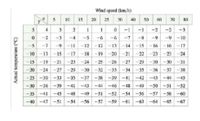
Concept explainers
In Example 2 we considered the function W = f(T, v), where W is the wind-chill index, T is the actual temperature, and v is the wind speed. A numerical representation is given in Table 1 on page 889.
(a) What is the value of f(−15.40)? What is its meaning?
(b) Describe in words the meaning of the question “For what value of o is f(−20, v) = −30?” Then answer the question.
(c) Describe in words the meaning of the question “For what value of T is f(T, 20) = −49?” Then answer the question.
(d) What is the meaning of the function W = f(−5, v)? Describe the behavior of this function.
(e) What is the meaning of the function W = f(T, 50)? Describe the behavior of this function.
Table 1 Wind-chill index as a function of air temperature and wind speed

Step by stepSolved in 5 steps with 10 images

- The function f(x) = (x +7)° is one-to-one. a. Find an equation for f(x), the inverse function. b. Verify that your equation is correct by showing that f(f¯'(x) = x and f1 (f(x)) = x. ..... a. Select the correct choice below and fill in the answer box(es) to complete your choice. (Simplify your answer. Use integers or fractions for any numbers in the expression.) O A. f'(x) = for x+ O B. f(x) = for xs OC. f'x) = for x2 O D. f'x) = for all xarrow_forwardConsider the function y = (fogoh) = „sin(e) • State the equations of the three functions h(x), g(x) and f(x) that compose this function. a) h(x) = %3D b) g(x) = c) f(x) =arrow_forward6) Does y = x have an inverse function?arrow_forward
- In the previous Problem Set question, we started looking at the position functions (t), the position of an object at time t. Two important physics concepts are the velocity and the acceleration. If the current position of the object at time is as (t), then the position at time h later is a (t+h). The average velocity (speed) during that additional time his (s(t+h)-s(t)) If we want to analyze the instantaneous velocity at time t, this can be made into a mathematical model by taking the limit as h→0. i.e. the derivative a' (t). Use this function in the model below for the velocity function (). h The acceleration is the rate of change of velocity, so using the same logic, the acceleration function a(t) can be modeled with the derivative of the velocity function, or the second derivative of the position function a(t) = ✔ (t) =" (t). Problem set question: A particle moves according to the position functions (t) = etsin (2). Enclose arguments of functions in parentheses. For example, sin…arrow_forward5.1: 11) Speedometer readings for a vehicle (in motion) at 6-second intervals are given in the table. Estimate the distance traveled by the vehicle during this 30-second period using the velocities at the beginning of the time intervals. distance traveled ≈ ?feet Give another estimate using the velocities at the end of the time periods. Distance traveled ≈ ?feetarrow_forwardIn the United States and Canada, the approximate shoe size for men is given by the function S(L)=3L−24, where L is the approximate length of the shoe in inches. (1) Fill in the missing values in the inverse function that converts shoe size to shoe length. L=S/( ) + ( ) (2) What is the approximate length of a size 6 shoe? ( ) inchesarrow_forward
 Advanced Engineering MathematicsAdvanced MathISBN:9780470458365Author:Erwin KreyszigPublisher:Wiley, John & Sons, Incorporated
Advanced Engineering MathematicsAdvanced MathISBN:9780470458365Author:Erwin KreyszigPublisher:Wiley, John & Sons, Incorporated Numerical Methods for EngineersAdvanced MathISBN:9780073397924Author:Steven C. Chapra Dr., Raymond P. CanalePublisher:McGraw-Hill Education
Numerical Methods for EngineersAdvanced MathISBN:9780073397924Author:Steven C. Chapra Dr., Raymond P. CanalePublisher:McGraw-Hill Education Introductory Mathematics for Engineering Applicat...Advanced MathISBN:9781118141809Author:Nathan KlingbeilPublisher:WILEY
Introductory Mathematics for Engineering Applicat...Advanced MathISBN:9781118141809Author:Nathan KlingbeilPublisher:WILEY Mathematics For Machine TechnologyAdvanced MathISBN:9781337798310Author:Peterson, John.Publisher:Cengage Learning,
Mathematics For Machine TechnologyAdvanced MathISBN:9781337798310Author:Peterson, John.Publisher:Cengage Learning,






